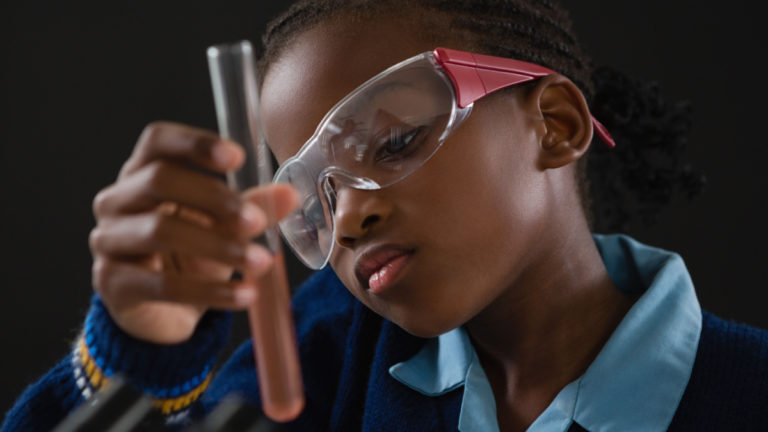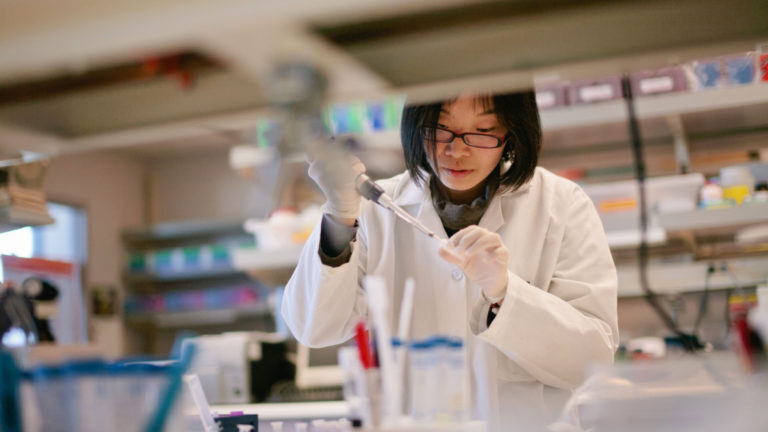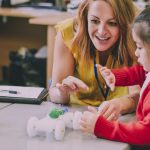The United Nations International Day of Women and Girls in Science (11 February 2024) is an opportunity to examine the disparities and tackle the barriers facing women in science, technology, engineering and mathematics (STEM).
While gender gaps in engineering, computer science and technology are closing, more can be done to encourage females to pursue potential jobs in these fast-growing and often lucrative career pathways, experts at South Australia’s Flinders University say.
Professor Giselle Rampersad is Dean of Education at the College of Science and Engineering and says female graduates will play a vital role in future workforce building – not least in mainstream engineering areas such as mechanical engineering and electrical and electronic engineering, with Australia reportedly short of 50,000 engineers and facing an urgent need to grow the sector’s workforce in the next three years.
She says collective effort is critical to increase the engineering pipeline to meet the needs of so many industries, including construction, energy and manufacturing.
“We need to address the perception that engineering and some other STEM careers are more suited to males and not as accessible or achievable for females from all walks of life.”
Girls’education key to unlocking potential for women in STEM
At Melbourne’s La Trobe University, academic experts say this Sunday’s special day is important for many reasons, with UN data delivering a reminder to keep breaking down the barriers and encourage more girls to pursue studies in science subjects.
- Women are often given smaller research grants than their male colleagues
- While women represent 33.3 per cent of all researchers, only 12 per cent of members of national science academies are women
- In cutting edge fields such as artificial intelligence, only one in five professionals (22 per cent) are women
- Despite a shortage of skills in most of the technological fields driving the Fourth Industrial Revolution, women still account for only 28 per cent of engineering graduates and 40 per cent of graduates in computer science and informatics
- Female researchers tend to have shorter, less well-paid careers
- Women’s work is underrepresented in high-profile journals, and they are often passed over for promotion.
Challenging stereotypes – sustainably
For the university’s Vice Chancellor’s Fellow and Distinguished Professor Jenny Graves, her connection to biological sciences makes this year’s theme for the annual international day – Women in Science Leadership: A New Era for Sustainability – especially meaningful.
To set more women up for STEM career success, she believes access to hands-on real observation and experiments is vital.
When it comes to the need to make a cultural shift that would see more families talk to girls about STEM subjects, Professor Graves says it could be useful to view it from the other way around.
“If girls are educated more in STEM, their kids and families will be more engaged with STEM,” she told EducationDaily. “It all starts with girls’ education …”
While the media landscape of books, television and film has historically shown men of science more than women, Dr Graves says the tide does seem to be turning and points to what she describes as “some great novels about woman scientists”, including Lab Girl and Lessons in Chemistry.
However, she told EducationDaily, “the stereotypes of driven, humourless woman scientists prevail”.
Encouraging secondary school students into the practical and potentially exciting world of citizen science, she says, could be a game-changer – and an antidote to the dull approach to science many high school students endure.
“High school chemistry is a killer of interest in science,” she says.
At a primary school level, attitudes of many teachers – “usually women who regard science with hate and fear” can also be off-putting, Professor Graves says.

Things are changing – but more support is needed
But there are definite signs of positive change.
At Flinders University, science enrolments have risen consistently, with data showing 38 per cent of students are female.
First-year electrical and electronic engineering student Madeline Macalister has also started a major in nuclear engineering – a first for a South Australian university in partnership with the US University of Rhode Island and University of Manchester, UK.
“I am the first person in my family to go to university and chose a science pathway after being inspired by the challenge of STEM and some fantastic female science teachers and other role models in high school,” says the 20-year-old, who works weekends in hospitality.
“I was in advanced science and math streams at Adelaide High School and have enjoyed the challenges at university so far.”
A possible internship at the University of Rhode Island nuclear research centre may take her on her first overseas trip in 2025.
“I work hard to achieve my goals and wish to encourage other young women to pursue male dominated science-based disciplines in their study or degrees,” she says.
Professor Ingo Koeper is Associate Dean (Learning and Teaching) at the College of Science and Engineering, as well as Professor of chemistry and nanotechnology, and is working on launching the new course with the overseas universities.
“The countdown to build the first SSN-AUKUS submarines in Adelaide is starting, with hundreds of new job and training opportunities in the pipeline,” Professor Koeper says.
Building strong foundations for a new generation of women in STEM
“A range of courses at Flinders University gives Australian graduates the opportunity to obtain a globally recognised defence industry certification, job placements, research opportunities and pathways to deepen study and research qualifications.”
“As well as the nuclear engineering major, Flinders also offers a number of micro-credentials for people from a range of industries looking to upskill,” says Professor Rampersad.
Ahead of International Women’s Day, the first of a series of 2024 STEM Enrichment Academy workshops for year nine high school girls from SA and NT will be held at Flinders University on 15 February. The regular workshops aim to raise awareness of career options and stimulate interest and passion for STEM.

For RRR students, the challenges can be greater
Emeritus Professor Dr John Halsey from Flinders University is Patron, Society for the Provision of Education in Rural Australia (SPERA).
He says access to top quality STEM education in regional, rural and remote (RRR) areas does occur – “but it does not occur at a fairly uniform high level”.
“The same can probably be said for urban and metro contexts as well- there is variability and one of the great and ongoing challenges in education is minimising variability while enhancing quality,” he told EducationDaily.
“There are at least three overall ways of improving access to STEM for RRR students. First, by identifying exemplary STEM practices and then scaling them up.”
To put it another way, he says, “build on what is already producing results and/or showing great promise”.
“Second, establish STEM hubs in RRR locations with either resident or fly-in-fly out expert teachers and mentors as well as utilising on-line learning from national and international centres of excellence. Hubs could/should be linked to state-of-the-art STEM based industries and businesses in areas such as primary industries and sustainable/renewable energy production and distribution,” Dr Halsey told EducationDaily.
“Third, establish a fleet of mobile STEM learning centres, such as The Big Red Truck.”
Role-models matter
Maria Parappilly is Professor of Physics at Flinders University’s College of Science & Engineering and Director of the STEM Enrichment Academy.
She says engaging young girls at a primary school level will be more successful with the introduction of role-model interventions, including role-model talks, walking with role-models.
“STEM Enriched girls loved the role-model stories,” Professor Parappilly told EducationDaily.
“In our survey, 73 per cent of respondents said they have no role models in a science career and about 50% of them said they do not know anyone in their family pursuing a science career. To inspire girls, who usually do not see anyone in their family engaging in a STEM career, role-model intervention can play an important role.”
For example, she says, “a few girls said they got inspired by the fact that they can change into other STEM degrees while at uni without being set on one career path”.
After listening to the role-model talks, they appreciated that the degrees are not fixed.
“More role-models to tell them their STEM story/journey. Through this, we can dismantle barriers that may arise from a lack of role models within their families, and thus promote a cultural shift to encourage more girls towards STEM-based studies and organisations.”
Offering hands-on science connections also creates positive change.
“Girls love experimentation, so deliver hands-on activities through a storytelling approach, and show them the diverse and different opportunities in STEM,” Professor Parappilly told EducationDaily.

Overcoming inequity and under-representation
Monash University’s Dr Felicity McCormack – Senior Research Fellow, School of Earth Atmosphere and Environment, Faculty of Science – says “being a woman in the geosciences can be challenging due to gender inequities and under-representation of females in these careers”.
“These challenges are largely systemic, and there’s a lot of research out there on how institutions can improve diversity and inclusion for women,” she says.
“In my own career, I’ve found it helpful to build a solid support system and to find excellent mentors. The importance of celebrating an international day for women in science cannot be overstated: it showcases achievements of women in science, champions diversity, and provides inspiration for all generations.”
Success will grow from greater inclusivity
Inclusivity, says her Monash University School of Earth Atmosphere and Environment colleague Associate Professor Vanessa Wong, is essential.
“Let’s reflect on the importance of making science inclusive for all today on the UN International Day of Women and Girls in Science,” she says. “The exclusion of certain demographic groups and the perpetuation of inequality are detrimental to the scientific community, and place constraints and barriers on our collective pursuit of knowledge and breakthroughs.”
“Recognising this, I am committed to embedding the principles of equity, diversity and inclusion into our scientific practices and workplace. By fostering an environment that embraces diversity we promote fairness and inclusion in our science to make a larger collective impact in our scientific discoveries. Happy UN International Day of Women and Girls in Science, as we commit to building a more inclusive and vibrant scientific landscape together!”
Associate Professor Rashina Hoda, Associate Professor (Software Engineering) and Associate Dean (Equity Diversity and Inclusion), at the uni’s Faculty of Information Technology, agrees.
“The UN International Day of Women and Girls in Science is an opportunity to remind us of all the amazing contributions of women to the STEM community and also to remind us to better support girls and women in STEM, especially those from diverse backgrounds and underrepresented communities,” she says.
“On this International Day of Women and Girls in Science, I encourage you to look up Margaret Hamilton, Burçin Mutlu-Pakdil, and Gladys West, as just three of many women who have made foundational contributions to STEM.”
Reach for the glass ceiling – then smash through it
Back at La Trobe University, Head of the Structural Biology and Bacterial Pathogenesis laboratory Professor Begoña Heras says her advice to girls/women aspiring to STEM careers is to “pursue your passion, be yourselves and be confident, find allies of all genders who will champion you, be resilient and embrace failures as learning experiences – which I know is difficult”.
Meaningful change in the workplace, she believes, will flow down to motivate more girls to want to be what they can see.
“Changes enabling greater female participation in STEM include flexible work arrangements, blind hiring/grant processes to reduce bias, mentoring programs, highlighting successful female role models and overall fostering inclusive environments where diversity is highly valued.”
It wasn’t that way for her university colleague, Associate Pharmacology Professor Elly Djouma, but her determination ensured success still came.
“Throughout my education, I didn’t encounter many women in leadership positions in STEM, let alone women from CALD backgrounds. Today I feel very proud when students ask me about my STEM journey. Being able to share my experience and inspire young women to pursue a career in STEM is hugely rewarding,” she says.
“My words of wisdom to girls and/or women aspiring to have a career in STEM is to trust in your ability and persevere. There are so many paths that your career in STEM can take you – invest in yourself and you will find your way.”








